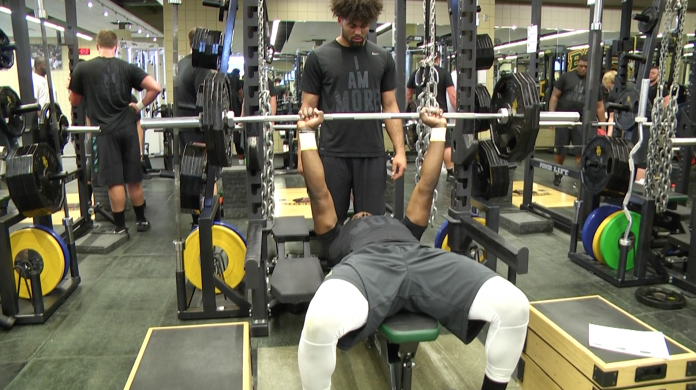Before each game, student athletes at Baylor put in hours of work behind the scenes, training to be in top shape to improve their athletic performance on the field or on the court. Baylor University’s Athletic Performance department works side-by -side with all the athletes to help them maximize their workouts. However now, the Athletic Performance department has gone one step further and found a new way to improve an athlete’s training.
Working with Athletigen, a sports genetics organization, the Athletic Performance department is working toward being able to tailor an athlete’s workout based on the genetic makeup of their DNA.
“Our job is to help our athletes,” said Chris Ruf, the director of athletic performance. “They may have a goal to get to a certain place athletically in four or five years and that’s good to have a goal like that, but we need to take care of the everyday things. We need to train hard, train smart and make sure we are doing the most appropriate things for an athlete to help them get better.”
The way it works is simple. DNA samples are collected from an athlete’s skin cells and saliva, which are then sent to Athletigen, where they are analyzed to identify different athletic factors in the athlete’s genetic makeup. So far, there have been about 10 to 15 different athletic factors that have been identified, including the ACTN3 gene, which is a gene known to predispose someone for being powerful.
With this new breakthrough, trainers can also look at an athlete’s predisposition to injury from the collagen makeup in their tendons and ligaments, nutritional factors, like how well their body responds to calorie restriction or calorie excess when it comes to weight gain or weight loss, and their sensitivity to different foods. In addition, this tool can also be used to predict how long an athlete might need to recover from an injury or come back from a break.
“We are excited about this because we can now help athletes figure out a little bit more about what makes them tick athletically from a physical standpoint, a nutritional standpoint and even a mental standpoint,” Ruf said. “We can take some of these findings and apply that to [an athlete’s] training so we are training the right aspects of their physical make-up.”
While training programs for athletes are typically differentiated more for each athlete during the off-season, workout plans are tailored for some athletes year-round.
“In the case of someone coming off of an injury or someone like Shawn Oakman, where you are 6’8, or Laquan McGowan, where you are 6’8 and [weigh] 420 [pounds], you just kind of need your own individualized program,” said Andrew Althoff, the director of applied performance.
When developing specialized training plans, Althoff said they take into consideration the athlete’s size, weight, body stature,and position.
“Right now we are figuring out how everything correlates,” Ruf said. “This is very new, it’s very cutting edge and we are excited about the process, discovery and figuring out more about what makes the human body tick.”
Ruf said they were focused on helping athletes meet the demanding needs of the different sports on campus to help them preform at their best and try to avoid injuries as much as possible.
“Athletics takes a toll on their body, and if we can help them through this to make better life style choices, that will impact their long-term,” Ruf said.
While using DNA to tailor an athlete’s workout plan can impact athletic performance short-term, it can also significantly impact athletes in the long run.
“One of the more exciting things is for when the athletes have this information, they now have information for life that they can use long after their athletic careers are done,” Ruf said. “Hopefully [it will allow them] to better manage their bodies nutritionally, physically and mentally so they can have better wellness, health and well-being as they get older.”






